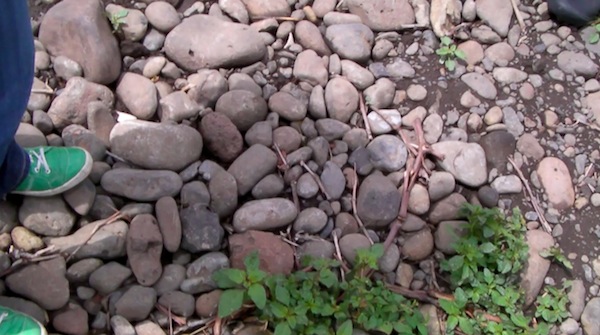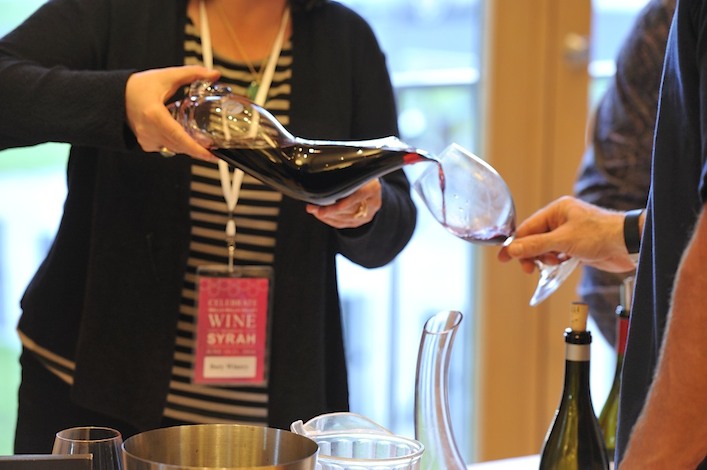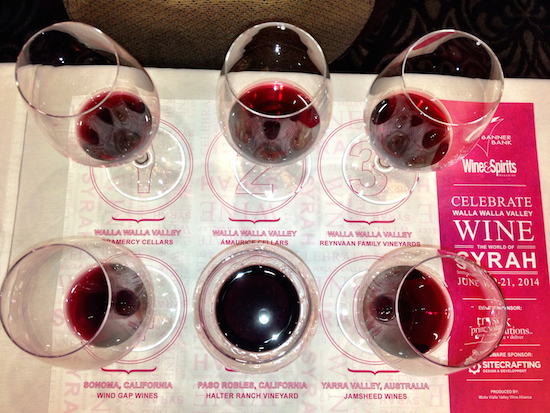
Editor’s note: This is the second of a two-part look at the winemakers panel from Celebrate Walla Walla Valley — The World of Syrah, a festival staged last month by the Walla Walla Valley Wine Alliance. Click here for the first installment.
WALLA WALLA, Wash. — Winemaking’s artistry often begins in the vineyard, and while modern-day harvest routinely is based on the chemistry inside the grape, for centuries winemakers relied on the flavor of the juice, the crunch of the seed and suppleness of the hanging cluster.
“I remember when I was first making Syrah and an old Frenchman came up to me and said, ‘You need to make wine when the grapes turn into an old woman’s boob. That’s when you pick it,” said Anna Schafer, winemaker of her family-owned áMaurice Cellars in Walla Walla. “I thought, ‘That’s interesting and visual. That’s one way of making it.’ ”
Schafer’s anecdote helped unbutton the mood in the conference room at the stately Marcus Whitman Hotel during the international panel of winemakers at the second annual Celebrate Walla Walla Valley Wine festival. It also added to the discussion about the personal approach winemakers can take while crafting small lots of Syrah — and how their styles continue to evolve.
“It’s really the only varietal in my mind where you have to be elastic about it,” Schafer said. “You can’t go, ‘Oh, it has to go this way.’ You have to follow it and taste it in the morning and taste it in the evening and adjust your (fermentation) temperature and adjust your extraction level. It’s a complete chameleon. That’s what I love about Syrah.”
One of the fascinating threads of the two-hour public seminar focused on whole-cluster fermentation and the embracing of stems.
“I’m a total stem freak when it comes to Syrah,” said Greg Harrington of Gramercy Cellars. “Most of the time we do between 50 and 100 percent full-cluster fermentation. That gives you tannin. It gives you structure. It gives you earthiness. I didn’t come here thinking that Syrah in the Walla Walla Valley needs stems, I just noticed that everyone I loved in the Rhône Valley used it.”
Harrington, who could be mistaken for another famous Walla Walla winemaker — retired NFL quarterback Drew Bledsoe — has proven to be an evangelist for Syrah stems.
“It’s always funny to me when someone says, ‘We do stem fermentation,’ ” Harrington said. “I say, ‘Oh, how much do you do?’ ‘Oh, like three percent.’ And I say, ‘No. Do 50, do 75, do 100 percent as an experimentation. Put something on the line.’ It seems like Walla Walla fruit really likes whole cluster. It like stems, and I don’t think that I’ve ever gotten to the point where ‘Oh, I think we overdid that one.’ ”
His influence has spread to the Syrah cellar of áMaurice.
“In the beginning I was making them larger and bigger and higher in alcohol, and Greg pounded it in my head, ‘We’ve got to try these stems,’ ” Schafer said. “I’m like, ‘I’m nervous. I don’t know if I can do it.’ So I’m bringing buckets over to him. We’re digging our teeth into these clusters and looking at stems and looking at chemistry and physiology.”
Harrington’s lure to Walla Walla began in Brooklyn
[youtube id=”qcjVfXBxvdg” width=”620″ height=”360″]
At age 26, Harrington made headlines in 1996 as the youngest American to earn the title of Master Sommelier. Within 10 years, though, he moved to Walla Walla with the purpose of becoming a winemaker.
“I spent 15 years basically buying wine for other people, and I started buying Washington wine in the early 1990s,” Harrington said. “I was running a restaurant in San Francisco called Square One, and I bought a case of Quilceda Creek and a case of DeLille and I got yelled at by the owner, who said, ‘Why are you buying Washington wine when you live in California?’ I just really loved Washington wines throughout my career.”
Harrington, a graduate of Cornell’s hotel administration program, remembers precisely when he first felt the pull of Walla Walla.
“I was running a restaurant group in New York City called B.R. Guest with 15 or so restaurants, and a bunch of Walla Walla winemakers were coming to give a tasting and basically throw a party in Brooklyn,” Harrington said. “It was a Sunday afternoon and I ended up meeting a bunch of the winemakers through Krista McCorkle, who ran the (Walla Walla Valley) Wine Alliance at the time and said, ‘You should come to Walla Walla and check it out.’ “
Two months later, Harrington and his wife, Pam, spent four days touring and tasting throughout the Walla Walla Valley.
“At one of these tastings, I was standing with Jean-François Pellet in the place where he was making wine at the time, which is now Amavi, and we were tasting Les Collines Syrah, and I said, ‘If I was going to make wine and make Syrah, I would want to make THAT.’ Norm McKibben was standing there, too, and he said, ‘We’ll sell you fruit if you want to come back here and make wine.
“We laughed, and then we went over to Va Piano to see Justin (Wylie),” Harrington continued. “And Justin said, ‘Hey, if you ever want to make wine, I’m going to be opening a winery, and we could share space.’ We came away saying, ‘We’re going to retire in Walla Walla and buy a little vineyard and when we’re 60 or 65, we’ll live the dream.’ ”
Within two weeks, the Harringtons began making plans to change their life.
“We were sitting on the couch watching some bad TV, and I said, ‘We should move to Walla Walla and start a winery now.’ And she said, ‘Why?’ And I said, ‘We’ll probably end up homeless when we do this, so let’s be homeless at 30 as opposed to when we’re 65.’
“She said, ‘OK.’ And I said, ‘Really?’ And she said, ‘Yeah, let’s do it.’ Literally, that’s how it happened. Within six months, I spent three weeks working at Pepper Bridge during the 2004 harvest. I quit my job Jan. 1, 2005, and in 2005 we did 800 cases of Syrah.”
Walla Walla Valley expresses itself in wind, stones

Panel moderator Rajat Parr asked the Walla Walla Valley portion of the panel to help describe the uniqueness of their area. Schafer said it starts in the hills.
“When you’ve got a warm summer’s day, you’ve got this incredible air drainage and when the heat of the valley floor rises, you’ve got this cool air coming off the Blue Mountains that really sets the acids,” Schafer said. “And in the evening, you have this incredible night cooling and the vines really do stop respirating in the evening. You can touch them when it’s 100 degrees and they are still cool to the touch. The wind that moves through this valley is very unique.”
But the buzz among the winemaking panel, which also represented California and Australia, continued to circle around The Rocks District of Milton-Freewater, the newly proposed American Viticultural Area on the Oregon side of the Walla Walla Valley.
“Obviously, The Rocks is incredibly unique,” Harrington said. “If you want to make smoked meat, roasted black pepper Syrah, that’s where you go. That’s different that any other place that I know of in the U.S.”
Gramercy Cellars doesn’t produce a single-vineyard Syrah from those cobblestones, but Harrington’s John Lewis Syrah — one of two he devotes to fruit from the Walla Walla Valley — taps into SJR Vineyard.
“I’m a big, big fan of Rocks fruit aromatically,” Harrington said. “There are some things structurally that are not exactly what I’m looking for, so we tend to use The Rocks fruit as salt and pepper as opposed to being a primary driver.”
Parr said, “The word terroir is used so many times, and in most times I’ll say it is overused, but in this respect it’s pretty amazing for a wine region which is fairly new. To already find your own terroir is pretty, pretty special. I don’t think I ever hear that word used correctly in California or in many other places.”
The rise of Reynvaan Family Vineyards
In some — not all — vintages, Syrah from Reynvaan Family Vineyards shows the influence of stems, but similarities to those of Cayuse Vineyards by Christophe Baron are natural. It starts in the cobblestone-filled area now known simply as “The Rocks.”
“My folks and I started this in 2004, and we met a crazy Frenchman who was talking about terroir,” Matt Reynvaan said. “He showed us the spot and said it was going to be something really special, but it was going to take a lot of time. We bought it and started planting in 2005.”
As the family established the vineyard, he worked for Marty Clubb at L’Ecole No. 41 and then Charles Smith of K Vintners.
“I wanted to learn more about what else was in the valley,” Reynvaan said.
A punishing lesson came five years after their initial plantings.
“The 2011 vintage was one of the more difficult years in Walla Walla because of the freeze we had in 2010,” Reynvaan said. “Our yields were down almost to a third of what they normally are, and when that happened, I thought, ‘I’d better make something great or I’ll need to look for another job.’
“It took a big financial toll on us cutting back as much as we did, but what was interesting is that we started to notice that it became quite a bit of a benefit because of the small clusters. There weren’t a lot of clusters, but they were perfect. And the stems were better than anything I think I’d tasted, so we ended up using more than we typically would.”
Less syrup, more crunch

Syrah made from The Rocks often carries a fingerprint of funk, but Parr, another master sommelier/winemaker, also appreciates Harrington’s winemaking style.
“One descriptor I always have for Greg’s Syrah is that it’s ‘crunchy,’ ” Parr said. “If you have a fruit that’s just perfectly ripe but not overripe — like a cherry — it’s crunchy. You bite into it and you feel the pulp, the fruit has something that it’s giving back to you. It’s very easy to get on the overripe side that’s heavy and bulky.
“That describes Gramercy Cellars wines for me,” Parr added. “Crunchy, fresh and vibrant and good acidity. If you have overripe and sweet Syrah, then it’s not interesting.”
Harrington said that’s because he focuses on the seeds when determining when to harvest.
“We pick Syrah only on seed ripeness,” Harrington said. “The seeds change from being very bitter to the day before we pick when they taste like roasted unpopped popcorn kernels. The seed isn’t bitter, and it doesn’t go to powder. It just stays crunchy.”
Those seeds, skins and stems drive the direction of Syrah at Gramcery Cellars.
“One thing that I find in Walla Walla is that I actually think our wines need a little more tannin,” Harrington said.
And to preserve the earthiness in Syrah, it’s important to reduce hangtime, he said.
“I get myself in trouble for saying things like this, but for me, if you really want to show terroir, if you get too ripe, that terroir disappears,” Harrington said. “As the fruit flavor intensifies and amplifies, the earth flavor tends to go away. I can find a zillion examples against that from around the world where that doesn’t happen, but I know from our wines that if we pick them a little early, I tend to like them a little more.”
Harrington also leans toward neutral oak puncheons to preserve the sense of place.
“I think that’s kind of the perfect vessel to age Syrah,” he said.
And Parr said there’s growing interest for adventurous Syrah projects.
“A great thing about the United States right now is there are a lot of people — particularly in California — who are going to a very traditional style and leading the way for the rest of us,” Parr said. “I don’t think that would have been possible 20 years ago. We’re at a unique place where we can actually experiment and put wines on the market without wondering ‘How is this wine going to score? or ‘How are we going to sell 10,000 cases?’ ”
Harrington hails 2010 vintage

“To me, this was the most interesting vintage that we’ve done so far,” the Gramcery Cellars winemaker said of the 2010 Syrah he brought to the panel tasting. “We may look back 25 and 30 years from now and say that 2010 was maybe the best vintage that we ever made. The reason I found 2010 so interesting is that a lot of times in the New World we’re dealing with the opposite of what the Old World is dealing with. A lot of times in the Rhône Valley they have flavor ripeness but they are waiting for ‘fizzle’ — the acid to come down and tannin to come down.
“Here, we’re trying to put the brake on the vineyard and keep the sugars down while waiting for the flavor to come up,” Harrington continued. “And 2010 was the first vintage that I’ve tasted here that I’ve been involved with where we had flavor first and waiting for the Brix to come up a little bit and the acid to go down. It’s really nice to make wine that way because you can pick at your leisure. And 2011 was a vintage like that as well.”
Here’s a look at the six Syrah spotlight during the seminar. The wines were not evaluated under blind conditions.
Gramercy Cellars 2010 Syrah, Walla Walla Valley, $55
The aromas from this product of Les Collines Vineyard (80%) and SJR Vineyard in proposed appellation of The Rocks of Milton-Freewater (Ore.) brought signs of fresh purple fruit, a sense of grapiness, black pepper and white pepper, followed by a palate-pleasing feel of acid-driven fruit such as raspberry and cranberry. Production: 595 cases. Alcohol: 13.9%
aMaurice Cellars 2010 Fred the Hummingbird Estate Syrah, Walla Walla Valley, $47
Anna Schafer’s offering, made with 50% whole-cluster fermentation, starts off with high-toned red fruit aromas driven by minerality, with lime peel, white pepper and chalkboard dust. There was nothing misleading with the juice, reminiscent of Pinot Noir from the Dundee Hills as it focused on raspberry and cranberry. Production: 365 cases.
Reynvaan Family Vineyards 2011 The Contender Syrah, Walla Walla Valley
It definitely wears its heritage from the Milton-Freewater cobblestones by presenting gamy and funky tones of alfalfa, saddle leather, steak blood and green peppercorn with grape fruit leather, high acid and a bit of heat. Price, technical information not available.
Halter Ranch Vineyard 2012 Block 22 Reserve Syrah, Paso Robles, $55
Perhaps the most hedonistic and approachable of the flight, it showcased aromas of raspberry, horehound, black licorice, violets, lavender and roasted coffee. Black currant joined in on the palate, which offered sandy tannins and juicy acidity. Price, technical information not provided.
Jamsheed Wines 2012 Healesville Syrah, Yarra Valley, $40
The winemaking methods — carbonic maceration for 55 days — raised eyebrows, and the results were strikingly similar to Carménère from Horse Heaven Hills or Cabernet Franc from the Yakima Valley. It was fascinating with aromas of black currant jam, Raisinet and green peppercorns, and there was a delivery that matched on the palate, which included red currant, raspberry and cranberry. It’s a hemisphere apart from the cheap Shiraz that’s been foisted upon Americans for years. Production: 250 cases.
Wind Gap Wines 2012 Armagh Vineyard Syrah, Sonoma
A fruit-forward and intense nose of Jolly Rancher grape candy, Aussie black licorice and white pepper leads into a pulsating acid-filled drink of Marionberry and fresh cranberry, backed by cranberry skin tannin. Price, technical information not provided.

Good evaluation of the syrah panel and wines. This was certainly one of the highlights of the Celebrate Walla Walla World of Syrah!
A couple of notes. The Halter Ranch Syrah did stand out from the rest, or was at least pretty different than the other five syrahs, almost a fruit bomb taste.
What was amazing to me as well was how all the wines changed in the the couple of hours they were poured for the crowd and then the hour and half of winemaker talks. I had nothing left in the glass for the Jamsheed syrah, but could still smell its bouquet for a half hour or longer. In all a remarkable afternoon of wine!
Greetings Ed,
Thank you for taking the time to comment. Those two hours of discussion prompted me to think of Syrah differently, and I believe the strive to showcase terroir and the winemakers’ approach to Syrah in the Walla Walla Valley are akin to that of Pinot Noir in the Willamette Valley. Perhaps that’s why the panel discussion reminded me of the Oregon Chardonnay Symposium held in March. If the public wants to learn more about a particular variety, I strongly recommend they consider attending seminars such as these.